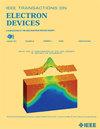ALD Al2O3-Engineered Schottky Barrier Interface for Amorphous Indium–Zinc Oxide
IF 3.2
2区 工程技术
Q2 ENGINEERING, ELECTRICAL & ELECTRONIC
引用次数: 0
Abstract
The interaction between metal and oxide semiconductors (OSs) is critical for advancing OS applications in large-area, flexible, and heterogeneously integrated electronics. Both ohmic and Schottky contacts are essential in these devices. The abundant intrinsic defects in OSs promote ohmic contact formation but adversely affect the Schottky barrier interface, especially in OSs with diverse sub-bandgap states, such as amorphous indium–zinc oxide (a-IZO). This study introduces an ultrathin alumina (Al2O3) interlayer, deposited via plasma-enhanced atomic layer deposition (PEALD), to effectively reduce interface defects and metal-induced gap states (MIGSs) between a-IZO and the platinum (Pt) anode. The top-anode a-IZO Schottky barrier diode (SBD) demonstrates a Schottky barrier height (ALD al2o3 -工程的非晶态铟-氧化锌肖特基势垒界面
金属和氧化物半导体(OS)之间的相互作用对于推进OS在大面积、柔性和异构集成电子领域的应用至关重要。欧姆触点和肖特基触点在这些器件中都是必不可少的。os中大量的本征缺陷促进了欧姆接触的形成,但不利于肖特基势垒界面的形成,特别是在具有不同亚带隙状态的os中,如无定形铟-氧化锌(a-IZO)。本研究引入了一种超薄氧化铝(Al2O3)中间层,通过等离子体增强原子层沉积(PEALD)沉积,有效地减少了a-IZO和铂(Pt)阳极之间的界面缺陷和金属诱导的间隙态(MIGSs)。顶阳极a- izo肖特基势垒二极管(SBD)的肖特基势垒高度($\Phi _{\text {B}}$)为0.73 eV,理想因数(n)为1.35。这种超薄Al2O3工程有效地提高了高质量OS肖特基接触的可行性。
本文章由计算机程序翻译,如有差异,请以英文原文为准。
求助全文
约1分钟内获得全文
求助全文
来源期刊

IEEE Transactions on Electron Devices
工程技术-工程:电子与电气
CiteScore
5.80
自引率
16.10%
发文量
937
审稿时长
3.8 months
期刊介绍:
IEEE Transactions on Electron Devices publishes original and significant contributions relating to the theory, modeling, design, performance and reliability of electron and ion integrated circuit devices and interconnects, involving insulators, metals, organic materials, micro-plasmas, semiconductors, quantum-effect structures, vacuum devices, and emerging materials with applications in bioelectronics, biomedical electronics, computation, communications, displays, microelectromechanics, imaging, micro-actuators, nanoelectronics, optoelectronics, photovoltaics, power ICs and micro-sensors. Tutorial and review papers on these subjects are also published and occasional special issues appear to present a collection of papers which treat particular areas in more depth and breadth.
 求助内容:
求助内容: 应助结果提醒方式:
应助结果提醒方式:


